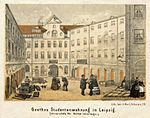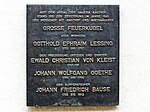Big fireball (Leipzig)
The Great Fireball was a historic residential and commercial building in Leipzig that was destroyed in World War II.
location
The big fireball had the address Neumarkt 3. However, the property extended over an inner courtyard to Universitätsstrasse. The house there was number 8. In the course of history, neighboring properties were also included.
history
In the 16th century, the property on Neumarkt (until 1839 Neuer Neumarkt) was built on with two houses and on Universitätsstrasse (until 1839 Alter Neumarkt) with three. In the north of the Neumarkt houses there was an inn "Zum Güldenen Kreuz". The southern one was sold in 1534 and so did the houses on Universitätsstrasse and the associated land at the beginning of the 17th century.
During the Thirty Years' War , when Leipzig was bombarded by the Swedes on October 21, 1642, a fire bullet hit the inn without causing any major damage. From 1644 the house and inn were called "Zur Feuerkugel".
In the years 1695–1697, the owner of the fireball, the Leipzig councilor Johann Ernst Kregel (from 1697 Kregel von Sternbach), rebuilt the house from scratch. The baroque building had a ground floor, two upper floors and three attic floors and was eleven window axes wide. Between 1700 and 1713 he bought back the three houses in Universitätsstrasse and connected them with the Feuerkugel house in a new building in 1711. He also created a courtyard passage between the two streets. In 1753, Christian Gottfried Winckler, who is now the owner of the fireball, bought the neighboring house back.
1755–1757 Gotthold Ephraim Lessing prepared himself in the fireball for an educational trip with the son of the house owner. The Prussian officer and poet Ewald Christian von Kleist , who made friends with Lessing here, also stayed here in 1757/58 . During his student days in Leipzig, Johann Wolfgang von Goethe lived in a courtyard building of the fireball from 1765 to 1768 . On February 7, 1776, the Freemason Lodge Balduin was founded in the Gasthof Feuerkugel , and the copper engraver Johann Friedrich Bause also lived in the house from 1794 to 1812 .
In 1788 the two houses on Neumarkt were sold individually again. To distinguish the two, the names "Large Fireball" (for No. 3) and "Small Fireball" (for No. 5) appeared.
In the 19th century, a third and a fourth floor were added to the Great Fireball. Around 1860 the general German Creditanstalt office was on the second floor. At the beginning of the 20th century the building was used as an exhibition center.
The house, in which a restaurant was in operation until the end, was destroyed in the bombing of December 4, 1943 . After the ruins were removed, the property remained undeveloped for over 50 years. When the “Galeria Kaufhof” department store was built on the Neumarkt 1–7 property in 2000/2001, it was part of the Big Fireball. At the Galeria Kaufhof, a plaque commemorates the famous former residents.
literature
- Ernst Müller: The house names of old Leipzig . (Writings of the Association for the History of Leipzig, Volume 15). Leipzig 1931, Reprint Ferdinand Hirt 1990, ISBN 3-7470-0001-0 , pp. 48 and 83
- Horst Riedel: Stadtlexikon Leipzig from A to Z . PRO LEIPZIG, Leipzig 2005, ISBN 3-936508-03-8 , p. 200
- Johann Wolfgang von Goethe: Poetry and Truth 6th Book ( online )
Web links
- The big fireball in the Leipzig Lexicon
- Johann Wolfgang Goethe - his traces in Leipzig
Individual evidence
- ↑ Gina Klank, Gernot Griebsch: Lexikon Leipziger Strasseennamen , Verlag im Wissenschaftszentrum Leipzig, 1995, ISBN 3-930433-09-5 , p. 155
- ^ Carl Weidinger: Leipzig. A guide through the city. Leipzig 1860, reprint VEB Tourist Verlag Berlin / Leipzig, 1989, ISBN 3-350-00310-9 , p. 88
- ↑ William Jähnl: The development and importance of trade fairs , C. Grumbach Leipzig 1922 ( online )
Coordinates: 51 ° 20 ′ 22.3 " N , 12 ° 22 ′ 36.2" E





